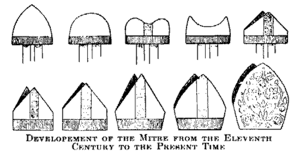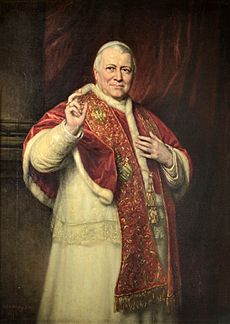Episcopal polity facts for kids

An episcopal polity is a way of organizing a church where the main leaders are called bishops. The word "bishop" comes from an old Greek word, epískopos, which means "overseer." Many big Christian churches use this system. These include the Catholic Church, Eastern Orthodox, Oriental Orthodox, Church of the East, Anglican, Lutheran, and Methodist churches.
Churches with an episcopal system are led by bishops. Bishops have authority in their local areas, called dioceses. They also meet in groups called synods or conferences. Bishops have two main roles: they perform important religious ceremonies like ordinations (making someone a priest) and confirmations. They also manage the clergy (priests and ministers) in their area. Many believe bishops get their authority from an unbroken line of leaders going all the way back to Jesus's first followers, the Twelve Apostles. This is called apostolic succession. In some church systems, bishops might report to higher-ranking bishops, like archbishops or patriarchs. These leaders often make big decisions for the church when they meet together.
For most of Christian history, the episcopal system was the only way churches were organized. This changed during the Protestant Reformation. Many Protestant churches then started using different systems, like those led by elected elders (Presbyterian polity) or by local congregations (Congregationalist polity). However, some people had questioned the episcopal system even before the Reformation.
Contents
What is Episcopal Polity?
The word "episcopal" can mean slightly different things to different Christian groups. But generally, it refers to churches led by bishops. These bishops are often seen as being part of an unbroken line of authority from the apostles.
This term also helps tell different church structures apart. For example, "Presbyterian" churches are led by elected elders. "Congregational" churches are led by their local members. "Episcopal" churches are led by bishops.
Sometimes, when you see "Episcopal" with a capital "E," it refers to specific churches that came from Anglicanism. These churches are often called "Episcopalian."
Here are some examples of churches that use an episcopal system:
- The Roman Catholic Church
- The Eastern Orthodox Church
- The Oriental Orthodox churches
- The Assyrian Church of the East
- The Churches of the Anglican Communion
- The Old Catholic churches
- Some national Lutheran churches
- The African Methodist Episcopal Church
- The United Methodist Church
Some Lutheran churches, like the Church of Sweden, have bishops who are part of the historic line of bishops. Many Methodist churches also use a form of episcopal leadership. They call their system "connexionalism." While their bishops have strong leadership roles, they are generally not seen as having the same apostolic succession as bishops in Anglican or Catholic churches.
A Look at History
In the early days of Christianity, the Apostle Paul and other early Christian writings mentioned "bishops and deacons." Some historians believe this means there wasn't a clear difference between bishops and presbyters (elders) at first.
However, by the early 100s AD, writings from people like Ignatius of Antioch clearly showed a difference between bishops and presbyters. This suggests that the episcopal system was already common by then. By the 200s AD, it seems that most Christians used the episcopal system. Even some groups that broke away from the main church, like the Novatians, still used bishops.
Some early Christian writers, like Jerome, believed that churches were first led by groups of elders. But they later chose bishops to help prevent disagreements and divisions.

Different Churches, Same Idea
The Catholic Church
The Catholic Church has an episcopal system with the Pope, who is the Bishop of Rome, at the very top. Catholics believe that the Pope's authority comes directly from Jesus Christ, who gave it to his first followers, especially Saint Peter. The Pope is seen as a visible sign of unity for all bishops and local churches around the world. He has teaching and leadership authority over the entire Church. This authority is passed down through bishops from one generation to the next through a process called the laying on of hands.
Eastern Orthodox Churches
The Eastern Orthodox Church also uses an episcopal system. They believe all their main bishops (called primates) gather around Christ. Other bishops then gather around these primates. There isn't one single leader like the Pope in the Catholic Church. However, the Patriarch of Constantinople is seen as the "first among equals." This means he is respected as the most senior leader among the independent Eastern Orthodox churches.
Oriental Orthodox Churches
The Oriental Orthodox Churches also believe in apostolic succession and episcopal leadership. In each of their national churches, the bishops form a holy synod. Even the Patriarch (their highest leader) is subject to this synod. For example, the Syriac Orthodox Church traces its line of bishops back to Saint Peter. The Armenian Apostolic Church traces its line back to the Apostle Bartholomew.
The Church of the East
Historically, the Church of the East traces its line of bishops back to Saint Thomas the Apostle. Today, the bishops of the Assyrian Church of the East continue this tradition of apostolic succession.
Anglican Churches
Anglicanism is a Christian tradition that came from the English Reformation. Anglicans also believe in the historic episcopate and apostolic succession. They trace their line of bishops back through the Church of England to early Christian times in Britain.
When King Henry VIII made the Church of England independent from Rome, he didn't change its basic structure. Bishops continued to be the leaders. Over time, Anglicans came to see bishops as having an important role in teaching and leading the church. They believe bishops pass down the power of ordination (making someone a priest). This helps ensure the church's mission is legitimate and keeps local churches connected to the wider Christian church.
Anglican bishops usually lead together in meetings called "synods" or "conventions." These meetings include not only bishops but also representatives from priests and regular church members. Decisions made in these meetings often need the bishop's approval to become official. While there's no single international leader in Anglicanism, the shared experience of having bishops and a link to the Archbishop of Canterbury helps keep them united.
American Methodist Churches
Many Methodist churches, like the United Methodist Church, use an episcopal system. They sometimes call it "connexionalism." Methodist bishops are often elected for life and have strong leadership roles. They are responsible for ordaining new clergy and assigning them to churches. They also lead important meetings and represent the church to other groups.
Episcopal Government in Other Denominations
Some Lutheran churches in Europe, like the Reformed Church of Hungary, also have bishops. Their system is similar to the Presbyterian system, but their bishops have more authority over local churches. The Lutheran churches in Sweden and Finland even claim apostolic succession, similar to Anglican churches.
Most Anabaptist churches, especially those that wear plain clothes, follow an episcopal system. While local congregations have a lot of say, bishops help keep unity between different congregations. They can also guide or discipline pastors.
The Church of Jesus Christ of Latter-day Saints (LDS Church) also has a strict hierarchy of leaders. This goes from local bishops up to a single prophet/president. Members are assigned to specific local congregations. This system developed over time from a more elder-led structure to a full episcopal one.
See also
 In Spanish: Episcopalismo para niños
In Spanish: Episcopalismo para niños
- Canon law
- Collegiality (Catholic Church)
- Conciliarism
- Conciliarity
- Episcopal subsidy
- Magisterium



